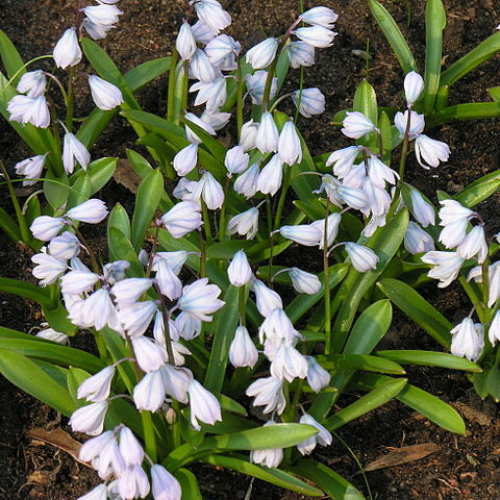Flowerbulbs Puschkinia

Description
Characteristic Features of Puschkinia
Puschkinia is a genus of herbaceous bulbous plants in the family Asparagaceae, subfamily Hyacinthaceae. Sometimes this genus is included in the lily family Liliaceae, apparently due to resemblance of its bell-shaped flowers to those of the Liliaceae.
In the wild, Puschkinia grows in damp areas among rocks and cliffs and is native mostly to Iran, the Caucasus, and the Middle East.
This plant is named in honour of the prominent Russian chemist Apollos Musin-Pushkin who first collected Puschkinias in the Caucasus while in search of very different objects, precious metals. This beautiful flowering plant is also commonly called "striped squill".
Puschkinia has linear deep-green leaves. The flowers are bell-shaped, with a strong but not very pleasant smell. They are located at the top of the stalk and gathered in racemes of 6 to 12 flowers. A corona with a toothed margin, similar to that of the daffodil, is located inside the bell. Flowers are borne in late April and May; they last for 3-4 weeks. The fruit is a capsule with pale brown rounded seeds. Puschkinia is propagated by seeds and perennial bulbs. The bulbs are oval, 2.5 centimetres across. It is noteworthy that one bulb can develop several stalks.
Puschkinia genus is presented by only two species; however, each of them is attractive and unique in its own way.
Puschkinia Hyacinthoides occurs in the Caucasus and Iran on stony slopes. This low plant (10-20 centimetres tall) has linear leaves and sturdy stalks up to 15 centimetres tall. The flowers are white or light bluish, about 1.5 centimetres in diametre, with blue streaks running down the middle of each petal.
Puschkinia Scilloides grows in the meadows and clearings. This species is notable for its two basal linear leaves that are narrower than those of Puschkinia Hyacinthoides, flexible stalks about 18 centimetres long and light blue flowers up to 2 centimetres across with bright blue stripes. Puschkinia Scilloides var. Libanotica has larger flowers, and Puschkinia Alba has all-white flowers.
Puschkinia is very ornamental and can be used in a variety of garden plantings. It looks great in rockeries, rock gardens, borders, mixed borders, especially close to Bluebells, Crocuses, and Chionodoxes, or fruit trees, currants, and gooseberries. Puschkinia is often used for cutting or forcing.
The Secrets to Successfully Growing Puschkinia
The plant is very easy to keep. For planting, choose sunny or partially shaded areas with fertile well-drained pre-fertilized soil (use humus or compost, ash, superphosphate, potassium chloride, and ammonium nitrate). Avoid planting Puschkinia in the areas where it can be affected by groundwater.
The basic care includes watering, frequent soil loosening, removal of dry leaves, and mulching with peat for the winter. In severe winters, cover Puschkinia with a layer of dry leaves. After flowering, cut the stalks so that nutrients go to the bulb. In severe winters, cover Puschkinia with a layer of dry leaves. It will ensure better quality of the planting material. Also, as with all bulbous plants, it is essential to remove weeds. Puschkinia will not do well or bloom well without thorough weeding.
To ensure fast and more intensive growth, first feed Puschkinia with mineral fertilizer in early spring as soon as the snow melts. After that, fertilize in the middle of spring and during flowering.
Puschkinias must be replanted every 5 to 7 years because they multiply and begin to crowd each other out. Propagation by bulbs is preferable. Once the bulb is mature in early summer, carefully dig it out and clean from soil, roots and old scales. Separate bulblets, dry and place for storage in a cool, dark, and dry ventilated area. Inspect the planting material once a week to detect damaged bulbs as soon as possible and immediately separate them from the rest of the bulbs. Please note that small bulbs will not bloom in the year of planting. They need rearing, so plant them in a special temporary place in the garden and replant in the permanent place the following year. Plant the bulbs in early autumn from mid-September to mid-October at a depth of 8-10 centimetres. Remember that the soil must be pre-fertilized and weeded. Space the plants at least at 10-12 centimetres apart. Bulbs usually root within approximately 2 weeks.
Seeds are usually planted in the autumn, immediately after harvesting. Young Puschkinias will only bloom on the third or fourth year. Self-seeding is possible but quite rare. The seeds contain essential oil that attracts ants thus eliciting seed-collecting behaviour.







 334
334







